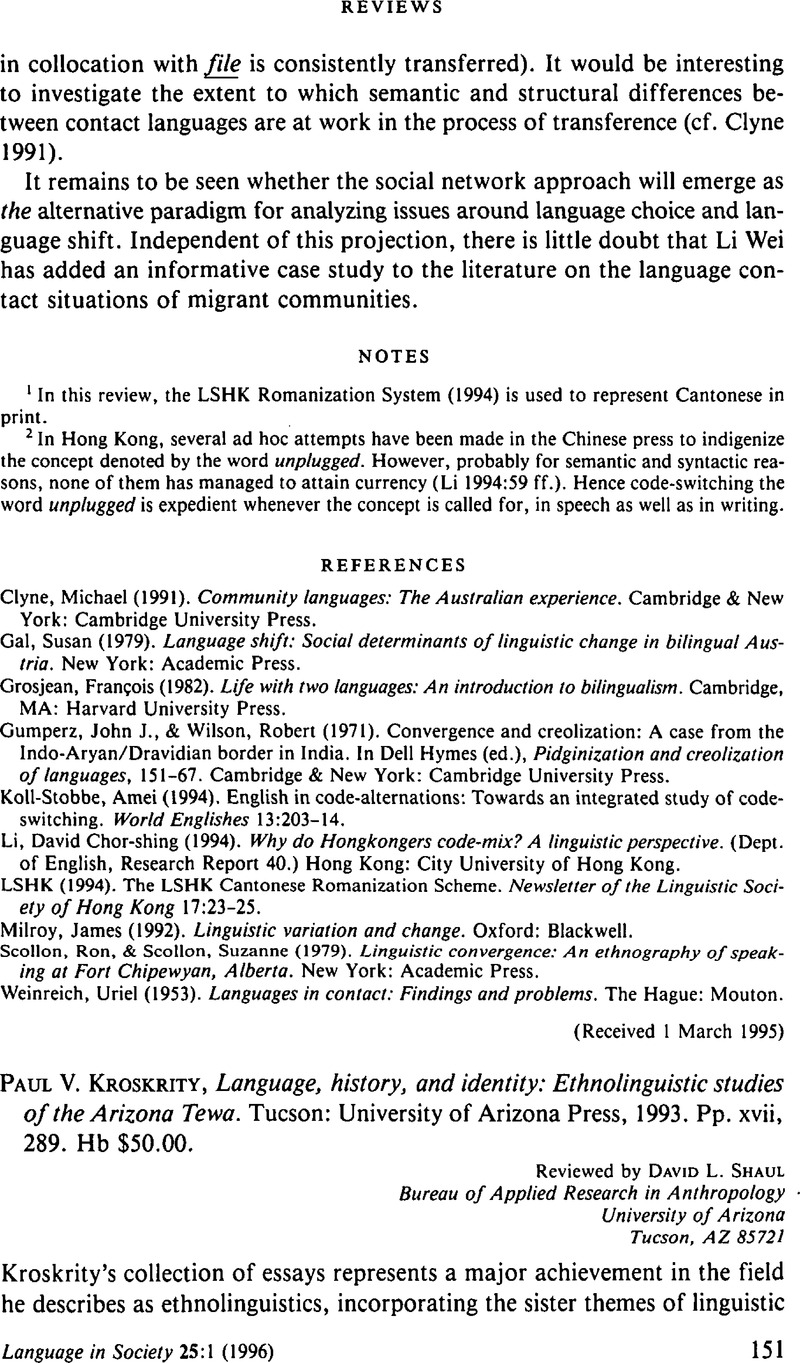No CrossRef data available.
Article contents
Paul V. Kroskrity, Language, history, and identity: Ethnolinguistic studies of the Arizona Tewa. Tucson: University of Arizona Press, 1993. Pp. xvii. 289. Hb $50.00.
Published online by Cambridge University Press: 19 February 2009
Abstract
An abstract is not available for this content so a preview has been provided. Please use the Get access link above for information on how to access this content.

- Type
- Reviews
- Information
- Copyright
- Copyright © Cambridge University Press 1996
References
REFERENCES
Dozier, Edward P. (1956).Two examples of linguistic acculturation: The Yaqui of Sonora and the Tewa of New Mexico. Language 32:146–57.CrossRefGoogle Scholar
Hale, Kenneth (1967). Toward a reconstruction of Kiowa-Tanoan phonology. IJAL 33:112–21.Google Scholar
kroskrity, Paul V. (1983). Male and female speech in the Pueblo Southwest. IJAL 49:75–79.Google Scholar
Kroskrity, Paul V. (1992). Arizona Tewa public announcements: Form, function, and linguistic ideology. Anthropological Linguistics 34:104–16. [Published 1994]Google Scholar
Kroskrity, Paul V. & Healing, Dewey (1978). Coyote and Bullsnake. In Bright, William (ed.), Coyote stories (IJAL Native American texts series, 1), 162–70. Ann Arbor: University Microfilms.Google Scholar
Kroskrity, Paul V., & Healing, Dewey (1980). Coyote Woman and the Deer Children. In Kendall, Martha B. (ed.), Coyote stories II (IJAL Native American texts series, 6), 119–28. Ann Arbor: University Microfilms.Google Scholar
Malotki, Ekkehart [& Talashoma, Herschel& (1978). Hopitutuwutsi: Hopi tales. Flagstaff: Museum of Northern Arizona Press.Google Scholar
Shaul, David Leedom (1987a). Cohesion in Hopi narrative. In Verschueren, Jef (ed.), Proceedings of the First International Pragmatics Conference, 579–84. Amsterdam: Benjamins.Google Scholar
Shaul, David Leedom (1987b). The Hopi coyote story as narrative: The problem of evaluation. Journal of Pragmatics 11:17–39.CrossRefGoogle Scholar
Shaul, David Leedom (1988). Topic and information structure in a Hopi radio commercial. IJAL 54:96–105.Google Scholar
Shaul, David Leedom (1993). Language, music and dance in the Pimeria Alta during the 1700s. Tumacacori, AZ: Tumacacori National Historic Park and Southwestern Parks and Monuments Association.Google Scholar
Shaul, David Leedom (1994). Two Hopi songpoems. In Swann, Brian (ed.), Coming to Light: Contemporary translations of the Native literatures of North America, 679–89. New York: Random House.Google Scholar
Spicer, Edward H. (1962). Cycles of conquest: The impact of Spain, Mexico, and the United States on the Indians of the Southwest. Tucson: University of Arizona Press.Google Scholar
Wiget, Andrew (1987.) Telling the tale: A performance analysis of a Hopi coyote story. In Swann, Brian & Krupat, Arnold (eds.). Recovering the word: Essays on Native American literature, 297–336. Berkeley: University of California Press.Google Scholar




